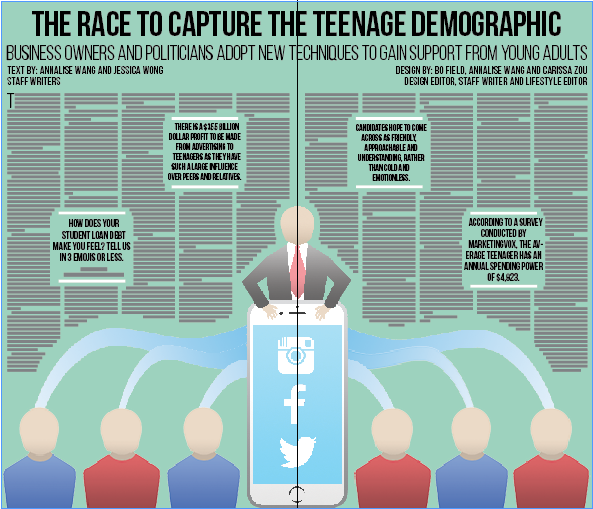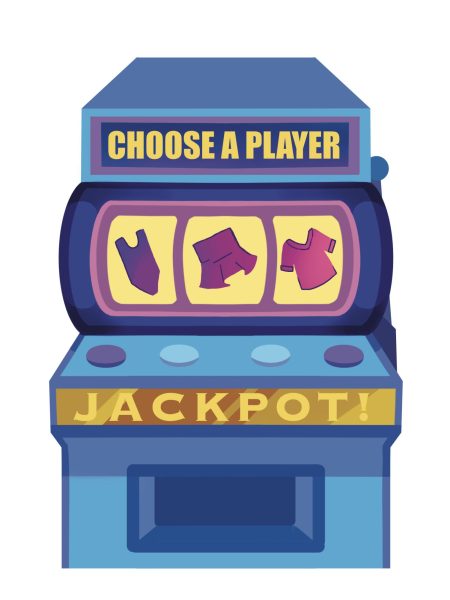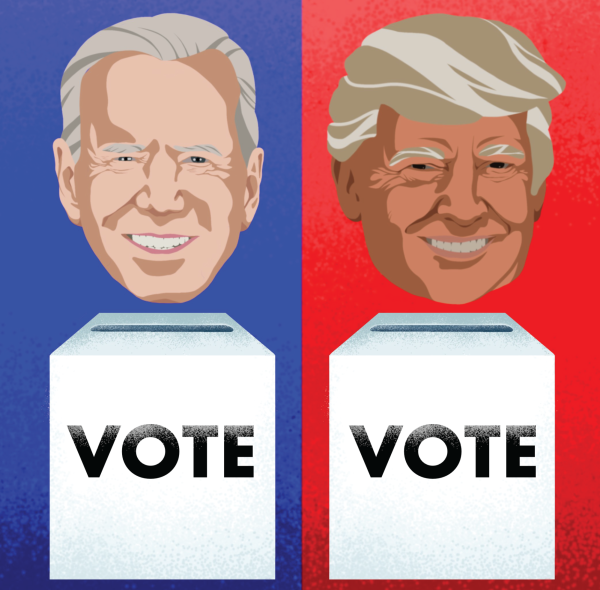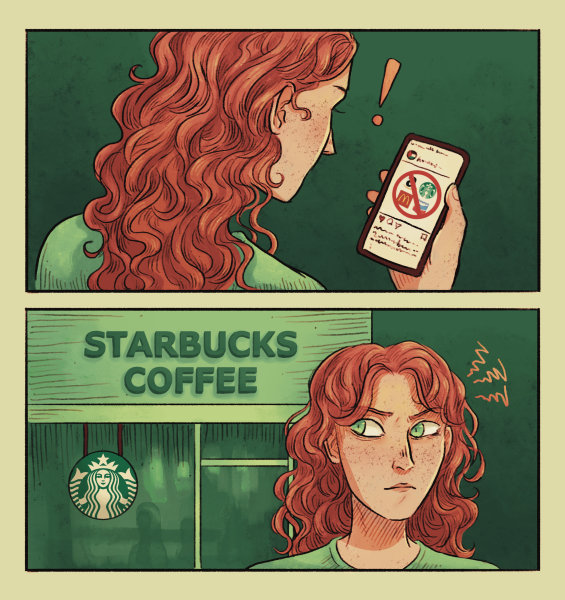The Race To Capture The Teenage Demographic
Business owners and politicians adopt new techniques to gain support from young adults

Teenagers hold the key to determining trends — everything from the latest crime show to watch to the most relatable politician to elect into office. These opinions are voiced through the most widespread methods of communication today: social media platforms, such as Facebook, Twitter and Instagram. Political campaigns and commercial businesses alike are racing to garner approval from younger audiences by using social media as a crucial marketing platform.
In the upcoming 2016 presidential election, an unprecedented amount of campaigning is taking place on social media. Candidates are trying to appeal to one of their most essential demographics: 18- to 24-year-olds.
Teenagers and young adults utilize their social media voices for a variety of reasons that can range from advocating for changes in the justice system to discussing pop culture. By using platforms such as Facebook and Twitter to document their reactions to current events, young adults send their messages of dissatisfaction or approval directly to others, and with the approach of the 2016 election, this voice extends to politics more so than ever before.
Historically, younger demographics have had the lowest voter turnout on election day, with just 45 percent of 18- to 24-year-olds voting in the 2012 presidential election, compared to 60 percent of 30- to 44-year-olds. However, according to a survey conducted by Fusion, a multi-platform media company, 90 percent of 18 to 24-year-olds are planning to vote in the upcoming presidential election. Out of these potential voters, 98 percent are also users of social media, based on a report published by The Next Web, a technology-focused media company.
For this reason, it is easy to see why presidential hopefuls are so keenly reaching out to voters via Facebook, Twitter and other forms of social media. In order to stand out from the competition, candidates use tweets, hashtags, posts and videos to connect with their voters and promote their political views, all in limited digital space.
In August, a tweet posted by Democratic candidate Hillary Clinton’s campaign team on her Twitter garnered widespread attention from adolescents and young adults on Twitter, though not for the intended reasons.
“How does your student loan debt make you feel? Tell us in 3 emojis or less,” Clinton said.
The tweet, clearly aimed at younger voters, was quickly ridiculed by its target audience and the awareness it brought to Clinton’s stance on college affordability was drowned out. However, the tweet also highlighted the gradual shift from campaigns of the past, which primarily focused on the usage of television and radio promotion, to campaigns of the present, which are increasingly centered around social media. Though the tweet did not generate the desired discussion for Clinton’s mission, it still managed to bring attention to Clinton herself, before another candidate could step in to steal the limelight.
How does your student loan debt make you feel? Tell us in 3 emojis or less.
— Hillary Clinton
In similar attempts to connect with younger voters, Republican candidates Jeb Bush and Marco Rubio have each posted their own videos about fantasy football on various social media sites. While Bush’s video discussed his outlook for his team and Rubio’s video spoofed rival candidates’ teams, the intent of capturing the attention of adolescents was clear.
Social media sites such as Twitter and Facebook provide platforms for young adults to react and express their opinions.
Hashtags can be used to support certain candidates. For example, the use of a hashtag such as #FeelTheBern can be used to show support for Bernie Sanders’ speeches and tweets, while others such as #GOPDebate and #DemDebate encourage Republican or Democratic debate-watchers to tweet and post about their views on each candidate.
It is no surprise that presidential candidates are doing everything they can to win approval through media platforms. According to an analysis published by the Center for Research and Information on Civic Learning and Engagement at Tufts University, despite the low number of 18- to 24-year-olds who voted in the 2012 presidential election, the youth vote gave Obama the advantage he needed to win a second term in office. With the high number of youths predicted to vote in the upcoming election, securing the 18- to 24-year-old vote is on every politician’s agenda.
In general, younger voters are more likely to vote for a presidential candidate who they feel they can relate to. Obama often receives praise on the Internet for his references to pop culture, which have included impersonating Grumpy Cat and offering campaign advice to Kanye West in the midst of speeches.
Similarly, some presidential candidates for the upcoming election want to demonstrate the same level of lightheartedness through tweets and videos to appeal to younger voters who may appreciate a sense of humor. Candidates hope to come across as friendly, approachable and understanding, rather than cold and emotionless. Doing so can make a young voter feel more comfortable with a candidate, especially those new to voting.
There is a $355 billion dollar profit to be made from advertising to teenagers as they have such a large influence over peers and relatives.
Dominating social media, young people essentially have the power to determine what is “in,” even when it comes to politics. When a large number of social media users like a particular politician, this positive image spreads. For example, Bernie Sanders’ popularity on the internet among many young adults has generated him a strong reputation, and those who may be unfamiliar with Sanders but frequently use social media will see predominantly positive messages about him.
Along with politicians, commercial businesses rely heavily on social media to directly target teenage consumers. Today, adolescents are arguably the most important demographic for companies to target, making up the largest market for music, films, retail and more.
As the youth vote becomes increasingly essential to political candidates, campaigns have placed a greater emphasis on social media presence in order to reach out to younger voting demogrpahics. By attempting to appear humorous and relatable on social media sites, candidates hope to convince voters that they truly understand the struggles and mindset of teenagesrs. Showing off these qualities, candidates hope to imply that under their hard exteriors, there lies something that resembles less of a politician and more of a friend.
With the support of teenagers and children comes massive amounts of money, and not just teenagers’ own money. Their influence over others such as family, friends and peers makes them a key target for all kinds of companies and retailers looking to make a profit. According to a study conducted by the RAND corporation, a public research compilation organization, companies spend roughly $180 billion annually advertising to young adults. Companies must compete with varying marketing strategies for the attention of teenagers, and keeping a teen interested for long proves to be a difficult task.
According to a survey conducted by Marketingvox, a researcher in the spending trends of Americans, the average teenager has an annual spending power of $4,923, which includes all the money spent on and for a teenager per year, including health insurance and the cost of living. According to U.S. Census numbers for 2014, there are currently about 31 million adolescents in the United States. These figures of money spent by teens total to be astronomical. According to numbers found in a survey conducted by West High, a public Iowa high school, teenagers on average spend $155 billion per year on advertised products and influence their parents to spend another $200 billion per year.
These numbers are record rates, soaring high over the previous record of the 90 billion dollars, adjusted for inflation, that the baby boomer generation of teens spent in 1953. In total, there is a $355 billion dollar profit to be made from advertising to teenagers as they have such a large influence over peers and relatives.
Young adults seem to largely influence decisions on purchasing technology in particular. Teenagers are, for the most part, more tech savvy than their parents. This means that all advertisers have to strategize how to incorporate the youth demographic into their advertisements, because after all, they are not only advertising their products to adults, but also to teenagers.
“This generation is a generation of teens that are passing down technology to their parents, not the other way around,” Mary Leigh Bliss, trends editor at YPulse, a youth-focused market research firm said in an online article.
Candidates hope to come across as friendly, approachable and understanding, rather than cold and emotionless.
Practically all industries make sure their ads are directed towards adolescents. There is one commonality to all these methods of advertising. They all take place on the Internet or on television.
The Internet has been a medium for communication regarding popular culture and social media sites and advertisers recognize this. According to a study conducted by Kaiser Permanente, the average adolescent spends seven and a half hours on social media or consuming some sort of digitized media every day. That is longer than some adolescents spend in school on a typical school day. Since social media is one of the largest and most influential aspects in a teenager’s life, it has become one of the main mediums used to target the high-school age demographic.
One market that is especially dependent on young adults is the music industry. Teenagers are, by far, the largest consumer of music. This generation is the generation of at least one earbud, if not both earbuds permanently stuck in their ears. Therefore, musicians must maintain desirable images to young adults if they want to succeed with their careers, and they can do this by communicating with their fans via these social media platforms.
Likewise, the majority of box office for films and ticket sales from theaters is accounted for by young teenagers. If you look around in a crowded theater, it is likely that you will see a sea of adolescents pockmarked by adults. Teenagers like to watch movies, as it is viewed as a social event for them. Movies, therefore, are hyped with trailers, sneak peeks and behind the scenes clips online that feature products strategically placed in by advertisers. For example, take the release of the new Star Wars movie. Trailers are being released slowly over time to build anticipation for the actual film to be released in late December 2015.
In addition, movies make more money from advertisers by strategically placing products at certain points in the movie. Advertisers know millions of teenagers will be watching these movies and that a product on the big screen can really help sell the product. Therefore, businesses are willing to pay a lot to have their product advertised in a box office success.
What teens do actually end up buying, however, is unpredictable. If advertisers make sure teens see their product on a constant basis, in every facet of their life, why aren’t the teenagers buying certain products? The answer is simple — teenagers depend on their peer networks for final approval. Shopping is very much a social experience for adolescents and includes a whole network of communicating what is “in” and what is “out” amidst the ever present desire of the teenager dream to fit in.
Young adults tend to be very malleable to the suggestions of the people they respect. This could be anyone, from a blogger to a celebrity to a peer they look up to. It is very common for teenagers to follow the trends set forth by their idols and the teenagers try to mimic them.
To attempt to attract teens’ attention, companies often hire celebrities to endorse their products. This could be through a paid tweet, Instagram post, vlog, interview or mention. Celebrities can make upwards of $50,000 for a simple tweet and top-paid celebrities can make anywhere between $7 million to $60 million for a campaign or commercial series, according to Forbes Magazine. For example, according to the Huffington Post, Beyoncé’s Pepsi endorsement deal made her $50 million.
According to a survey conducted by Marketingvox, the average teenager has an annual spending power of $4,923.
Not only do advertisements have to be tastefully done, they have to be memorable as well. Some ads try to use humor to relate to the consumer. Take the State Farm advertisements for example. “It’s Jake, from State Farm” is a line commonly recognized by children and adults alike. This effect is achieved by the abilities of the creators of this advertisement to make it humorous. This advertisement even turned into a widespread Internet sensation as well as a well-known advertisement. This is a great way to get publicity, as humor tends to appeal and unite the adolescents in a way that adults simply do not understand.
Another way to target the youth demographic is by using interactive ads. For example, take the Lucky Charms’ interactive game series. Mostly directed to sell cereal to the youth, the game is advertised on television and on cereal boxes. It is an immersive online adventure to find Lucky the Leprechaun’s charms. This type of ad piques interest and provides entertainment, thereby keeping Lucky Charms in consumers’ minds and also in their shopping baskets.
It is not so easy to find out exactly what grabs teenagers’ short attention spans. Teenagers are extremely selective and picky about what they buy, but there seems to be one similarity: teens pay attention to whatever other teens do. They check out who their friends follow and what music is recommended by their peers.
From a moral standpoint, the constant barrage of advertising to teens does not sit well. According to Marketingvox, teenagers are exposed to 3,000 ads per day. It is both psychologically and physically damaging teenagers to be sitting in front of a screen for hours at a time being bombarded with media.
According to a study by York College, the constant use of social media causes alarming psychological effects such as a lowered attention span, anxiety and overstimulation of the brain. Additionally, a study from the Centre for Vision Research, a group that researches human vision asserts that screen-staring is corrosive to vision and leads to increased blood pressure, among other serious heart problems. This raises into question the issue of the ethics of a constant advertising onslaught upon adolescents.
Whether they are getting an obnoxious spam email from a local company, seeing Kylie Jenner raving about her fake hair extensions or watching their favorite movie when a Chevy logo flashes by, one is constantly being exposed to advertising through the medium of social media. Social media has become a connection point for the spreading of the latest trends, and companies and candidates are happy to employ their offerings to target young adults with their strategic advertising and product placement.
Your donation will support the student journalists of Palo Alto High School's newspaper

















